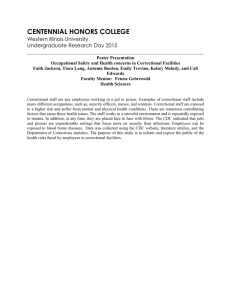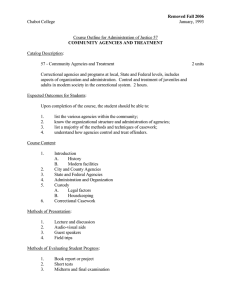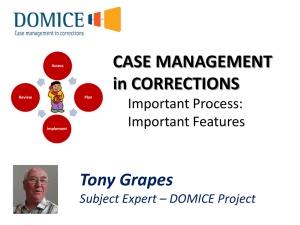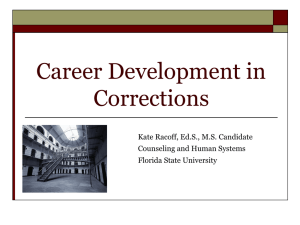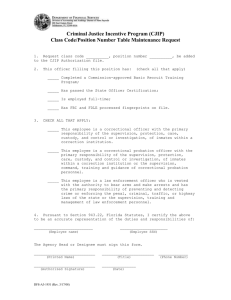Improving the Link Between Research and Drug Treatment in Correctional Settings
advertisement
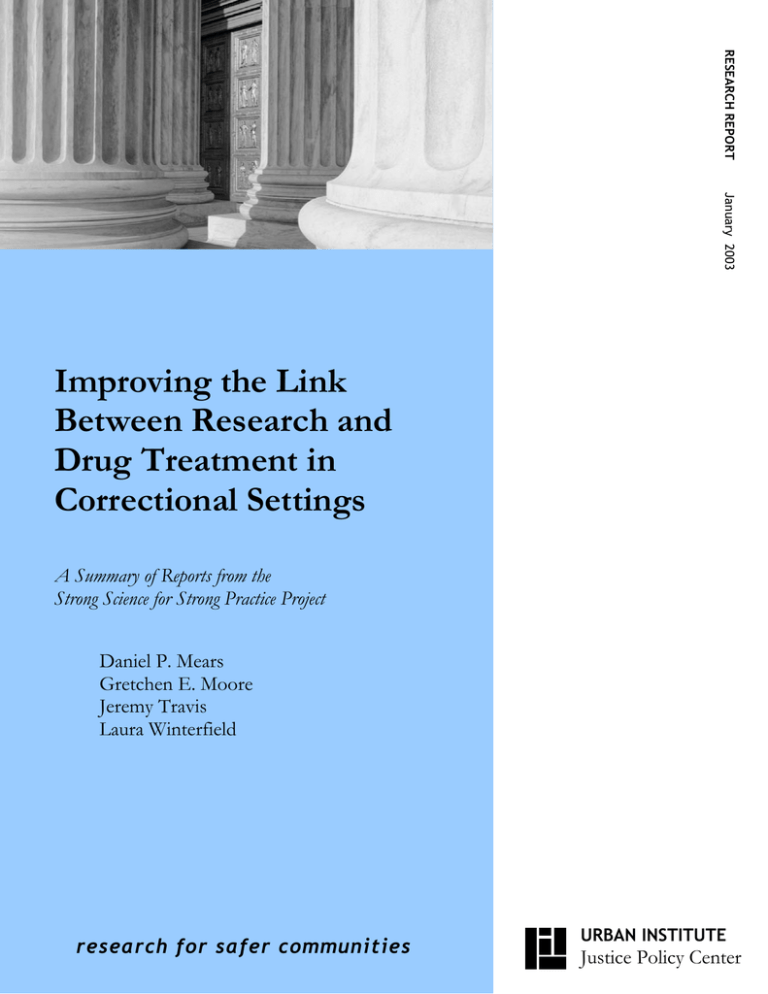
RESEARCH REPORT January 2003 Improving the Link Between Research and Drug Treatment in Correctional Settings A Summary of Reports from the Strong Science for Strong Practice Project Daniel P. Mears Gretchen E. Moore Jeremy Travis Laura Winterfield research for safer communities URBAN INSTITUTE Justice Policy Center Improving the Link Between Research and Drug Treatment in Correctional Settings* * A modified version of this report, “Strong Science for Strong Practice: Linking Research to Correctional Drug Treatment,” will appear in a forthcoming issue of the Offender Substance Abuse Report. This report is one of an Urban Institute four-part series on drug treatment in the criminal justice system: Drug Treatment in the Criminal Justice System: The Current State of Knowledge by Daniel P. Mears, Laura Winterfield, John Hunsaker, Gretchen E. Moore, and Ruth M. White Voices from the Field: Practitioners Identify Key Issues in Corrections-Based Drug Treatment by Gretchen E. Moore and Daniel P. Mears A Meeting of the Minds: Researchers and Practitioners Discuss Key Issues in Corrections-Based Drug Treatment by Gretchen E. Moore and Daniel P. Mears Improving the Link Between Research and Drug Treatment in Correctional Settings — Summary Report by Daniel P. Mears, Gretchen E. Moore, Jeremy Travis, and Laura Winterfield These reports are available as downloadable PDF files from the Urban Institute: w w w . u r b a n . o r g To receive free email updates on research from the Justice Policy Center, send an email to JPC@ui.urban.org. URBAN INSTITUTE Justice Policy Center 2100 M STREET, NW WASHINGTON, DC 20037 www.urban.org 2002 The Urban Institute Points of view or opinions expressed in this document are those of the author(s) alone and do not necessarily represent the official position or policies of the National Institute on Drug Abuse, the Urban Institute, its board, or its funders. Report design by David Williams ACKNOWLEDGMENTS The authors gratefully acknowledge the funding for this project, Strong Science for Strong Practice, provided by the National Institute on Drug Abuse (NIDA), Contract #N01DA-1-1104. The NIDA staff provided considerable support through-out all stages of this project. Special thanks are extended to Alan Leshner, Jack Stein, Pete Delany, Bennett Fletcher, and Jane Smither Holland. Glen Fischer of the Management Assistance Corporation assisted with the ongoing contractual issues in managing the project and helped ensure the success of the meeting of practitioners and researchers. Special thanks is given for the support provided by many Urban Institute staff, including Adele Harrell, Dionne Davis, Ruth White, John Hunsaker, and Dave Williams. Finally, we extend our appreciation and thanks to the many criminal justice practitioners and researchers who provided assistance with and/or participated in various stages of this project. Contents 1. INTRODUCTION ........................................................................ 2 2. R E SEA R CH G A P S O N DR U G T RE A T M E NT I N T H E ADUL T PRISON SYSTEM ............................................................... 4 Effective Approaches and Strategies for Drug Treatment in Prisons................................................4 Drug Treatment Implementation Issues in Prisons .....................................................................6 3. STRATEGIES TO ENCOURAGE SCIE NCE-BA SED D RUG TR E A T ME N T I N PR I S O NS . . . . . . . . . . . . . . . . . . . . . . . . . . . . . . . . . . . . . . . . . . . . . . . . . . .. . . 8 4. SOME PRINC IPLE S OF EFFECTIVE PRISON-BA SED D RUG TR E A T ME N T . . . . . . . . . . . . . . . . . . . . . . . . . . . . . . . . . . . . . . . . . . . . . . . . . . . . . . . . . . . . . . . . . . . 1 0 5. CONCLU SION.......................................................................... 12 6. NOTE S . . . . . . . . . . . . . . . . . . . . . . . . . . . . . . . . . . . . . . . . . . . . . . . . . . . . . . . . . . . . . . . . . . . . . . . . . . . . . . .. . 1 4 Improving the Link Between Research and Drug Treatment in Correctional Settings 1 1. INTRODUCTION A ccording to some estimates, only 61 percent of state correctional facilities provide substance abuse treatment. Despite a significant infusion of federal funds to support residential substance abuse treatment in prisons, the percentage of state prisoners participating in such programs declined from 25 percent in 1991 to 10 percent in 1997. The policy shortfall is clear: Inmates with substance abuse problems may not be receiving the treatment that would reduce their drug problems and criminal behavior. Why they are not getting treatment remains largely unknown. One possibility is simply a lack of political or correctional interest in providing drug treatment. But an equally plausible explanation is a lack of sufficient funding. In addition, there may be conflicting expectations, systems constraints, and philosophies. These and other possible explanations suggest that there are yet-to-be-specified roles that federal agencies might play to assist the integration of treatment into corrections. This report emerged from a collaboration between the Urban Institute and the National Institute on Drug Abuse (NIDA), the goal of which was to help identify and address the unique circumstances of the criminal justice environment and the challenges posed by the integration of treatment services and a public health orientation into this environment. To help achieve this goal, the study, funded by NIDA, included three components: (1) a literature review covering a range of issues pertaining to correctional drug treatment; (2) interviews with practitioners, such as directors of state correctional agencies or programming divisions; and (3) a meeting of researchers and practitioners to discuss issues raised from the literature review and interviews. Both the interviews and the meeting were designed to help bridge the gap between researchers and correctional 2 practitioners and to identify key issues and solutions for which practitioners have unique insight. The research components, summarized in three separate reports, were designed to help identify potential research needs, strategies for increasing science-based correctional drug treatment practices, and principles of effective drug treatment in correctional settings. This final report outlines several overarching themes from the previous reports. It begins by focusing on the identification of critical research gaps that, if addressed, would have important consequences for feasible and effective prison-based drug treatment. Here, we inquire about specific interventions and general strategies that may be effective, as well as factors that may affect their successful implementation in correctional settings. Interventions may include particular programs or treatment modalities. Strategies may include various activities (e.g., screening and assessment) that can contribute to effective drug treatment but do not necessarily constitute treatment themselves. The report then focuses on critical nuts-and-bolts research-to-practice integration strategies — that is, efforts aimed at encouraging the integration of science-based research with prison-based drug treatment. The goal here is to examine how research can better inform the practice and delivery of effective drug treatment in correctional settings. Building on these discussions, the report concludes by identifying some key principles of effective correctional drug treatment, drawn from insights that emerged throughout the project. These principles provide guidance about ways in which drug treatment in correctional settings ideally should be structured to improve outcomes among drug-involved prisoners. In short, this report — and the summary in Table 1 — provides a synthesis and distillation of critical Improving the Link Between Research and Drug Treatment in Correctional Settings research gaps, research and practice integration strategies, and principles of effective correctional drug treatment, as identified in our review of the research reports and the materials on which they draw. It should be emphasized that the three previous reports from this project provide more complete discussion and documentation of the issues raised here, as well as a range of related findings and concerns regarding drug treatment in the criminal justice system. In this report, we have restricted our focus to gaps, strategies, and principles that seemed particularly policy relevant and that could be feasibly implemented or addressed. Finally, the points raised in all of the research reports, including this one, necessarily touch on many aspects of the criminal justice system, but the primary focus in each instance is on the provision of drug treatment in prison-based settings. Improving the Link Between Research and Drug Treatment in Correctional Settings 3 2. RESEARCH GAPS ON DRUG TREATMENT IN THE ADULT PRISON SYSTEM In this section, we identify several of the most prominent research gaps emerging from our review of the literature on drug treatment in the criminal justice system and interviews with and a meeting of researchers and practitioners. These gaps represent areas in which research is needed on effective drug treatment approaches and strategies in correctional settings and on issues affecting the implementation of drug treatment in such settings. In each instance, we focus on gaps that are important and policy relevant and that may be feasibly addressed. prisoners with potential drug treatment needs. Assessment instruments should allow for accurate identification of the full range of prisoner needs and the most appropriate type and level of treatment, while taking into account security considerations. All instruments should be validated. For example, screening instruments should generate results that are moderately correlated with those of more sophisticated risk and need assessment instruments. By contrast, particular assessment instruments should be strongly correlated with particular outcomes (e.g., drug treatment need, mental or physical disorder, aggressive behavior, recidivism). It is important that these assessment instruments be validated for specific impact points within prisons and throughout the criminal justice system — for example, pretrial and presentencing hearings, probation, jail and prison intake, treatment in jail and prison, prerelease, postincarceration — because the goals of assessment may vary at each impact point. Effective Approaches and Strategies for Drug Treatment in Prisons Drug treatment, in this report, can refer to specific types of interventions (e.g., a behavioral modification approach) or to general strategies (e.g., an integrated system of screening, assessment, placement, monitoring, and evaluation). The effectiveness of both may be influenced by many factors, as suggested by the following research gaps. • • 4 Define more precisely and consistently what is meant by “drug treatment need.” Numerous studies state that prisoners have drug treatment needs. However, these studies generally rely on different definitions of drug treatment need and employ different criteria or measures for identifying treatment need. Develop validated screening and assessment instruments for various impact points within prisons and throughout the criminal justice system. There is a need for simple, short, and accurate screening and assessment instruments. These instruments should serve clear and distinct purposes. Screening instruments should allow for the accurate identification of Finally, for treatment purposes, assessment instruments should address additional concerns, such as the role of offender motivation and staff training, that may affect the validity of assessment instruments. • Identify and better understand the role of motivation in treatment. Although research suggests that drug treatment need not be voluntary to be effective, motivation, including readiness for change, nonetheless can be important. It can, for example, play a significant role in whether a prisoner receives or stays in treatment and how treatment is both perceived and experienced. Many researchers and Improving the Link Between Research and Drug Treatment in Correctional Settings practitioners believe motivation is one of the most critical issues to ensuring successful participation in and long-term benefits from prisonbased drug treatment.1 To date, however, relatively little research addresses this issue, including the source, kinds, and levels of motivation needed for treatment to be effective. • Conduct research on the relevance of general treatment principles to drug treatment in correctional settings. Considerable research attests to the importance of many principles of effective treatment, but the value and appropriateness of many of these principles have not been systematically evaluated in the context of correctional environments.2 • Clarify the extent to which coercion can be linked to motivation and effective treatment. Although much research indicates that coerced drug treatment can be effective, more research is needed on identifying the types of coercion that work and how perceptions of coercion play a role in reducing or increasing treatment effectiveness. Research also is needed that examines the relationship between coercion and motivation. • Examine how the effectiveness of drug treatment varies depending on the security levels of prisons. Relatively little is known about whether, how, or why drug treatment interventions vary in their effectiveness across minimum, medium, maximum, and supermaximum security prisons. For example, are specific treatment modalities affected by the security level of prisons, and, if so, what is the impact on treatment effectiveness? • Determine the balance of incentives and sanctions that are needed to be most effective with prison inmates and that are available in prison settings. Research should identify the balance of incentives and sanctions necessary to achieve the largest and most sustained reductions in drug use and criminal behavior among prison inmates. This research also should consider the unique set of incentives and sanctions available in a prison setting, and how these can be best applied on a case-by-case basis. • Explore how the transition into prisons and the reentry process into society influence the effectiveness of drug treatment. Each transition presents a range of challenges, any one of which might reduce treatment effectiveness and require targeted programming as well as collaborative efforts (e.g., within the criminal justice system and between the justice system and social service and community agencies). • Assess the cost-effectiveness of different drug treatment interventions. Because prisons operate with limited budgets, they require information about the most cost-effective approaches to increasing prison control and reducing longer-term drug use and crime. Few studies of the cost-effectiveness of different drug treatment interventions exist, however. In addition, research is needed on identifying the levels of drug treatment funding or pro- • Identify effective treatments for different stages of a prison term. Research is needed on the kinds of treatments that work best for prisoners during incarceration, the specific times during incarceration when treatment is most effective (e.g., throughout incarceration, at the beginning of a term of incarceration, or just prior to release), and the combinations of treatment that work best to reduce drug use and crime. Improving the Link Between Research and Drug Treatment in Correctional Settings 5 gramming in prisons that is most cost-effective for achieving these diverse goals. • • Evaluate how treatment orientations or philosophies in prisons affect drug treatment implementation. Diverse sources suggest that treatment orientations or philosophies of prison officials, staff, and providers can affect drug treatment delivery and, ultimately, effectiveness. Research is needed on precisely how a supportive treatment orientation can be fostered and sustained, especially among guards, as well as how this support affects treatment implementation and, ultimately, treatment effectiveness. • Identify how prison staff affect drug treatment delivery and effectiveness. How and to what extent do prison staff and the training they receive affect awareness about drug treatment needs? In addition, how do prison staff affect drug treatment implementation and, ultimately, treatment effectiveness? • Identify approaches to and instruments for screening and assessment that are most feasible to use in correctional settings. Screening and assessment are critical components of drug treatment, yet research suggests that frequently they are not conducted or the information from them is not used. Studies are needed that identify effective approaches to and instruments for screening and assessment. These instruments should yield valid information that can be easily used and shared by correctional staff. • Identify ways in which drug treatment can be implemented and integrated throughout the criminal justice system. Effective prison-based drug treatment requires consistent support and services throughout the criminal justice system, including services in the communities to which ex-prisoners are released. Conduct research on drug treatment within prison systems, not just specific drug treatment interventions. Research is needed on system-level factors that may influence the quality and effectiveness of all drug treatment interventions, not just specific interventions. To date, most research has focused on specific interventions while largely ignoring the larger institutional context affecting all drug treatment interventions. Drug Treatment Implementation Issues in Prisons Many factors may affect the level and quality of drug treatment implementation, which in turn can influence treatment effectiveness. Below, we review areas in which research is needed concerning drug treatment implementation in correctional settings. The discussion necessarily touches on issues of effectiveness, but the primary focus is nonetheless on implementation. • 6 Determine the nature and extent of current drug treatment need and practice. Currently, relatively little consistent or accurate information exists concerning the state of prison-based drug treatment need or practice, including drug treatment-related activities such as screening, assessment, and reentry planning. Basic descriptive research is required about the extent of need and state of practice, with both being consistently defined. Research also should focus on identifying factors that drive decisionmaking about levels and types of drug treatment programming. Improving the Link Between Research and Drug Treatment in Correctional Settings Drug treatment effectiveness is enhanced if treatment is well-integrated with other services and treatments before, during, and after incarceration. Research is needed on how drug treatment can be both implemented and integrated throughout the criminal justice system, and how barriers to both can be overcome. • Examine boundary-spanning and its impact on drug treatment in prisons. Conduct research on how boundary-spanning across different systems (e.g., justice, social service, welfare) can enhance the levels and kinds of drug treatment services provided in prisons and throughout the criminal justice system. Improving the Link Between Research and Drug Treatment in Correctional Settings 7 3. STRATEGIES TO ENCOURAGE SCIENCE-BASED DRUG TREATMENT IN PRISONS In this section, we provide a set of recommendations regarding strategies that federal and non-federal funding agencies and organizations might undertake with the corrections field or state partners to increase and improve appropriate, science-based treatment of drug offenders in correctional settings. • • Create a manual of correctional drug treatment principles. Create a manual outlining principles of effective drug treatment in correctional settings, including (a) well-established findings about drug treatment in the criminal justice system and (b) how drug treatment should be implemented to achieve the best results. This manual could parallel the NIDA publication, Principles of Drug Addiction and Treatment: A Research-Based Guide and ideally would extend the brief discussion on criminal justicebased drug treatment (pp. 31-33).3 Educate the public, policymakers, and prison officials that drug treatment can be an effective crime control measure and that it can be a cost-effective approach to maintaining prison control and reducing drug use. Effective drug treatment can potentially reduce crime. In general, political and correctional support is easier to obtain for crime control than for treatment. For this reason, the crime control aspects of effective drug treatment should be emphasized. In addition to reducing recidivism, drug treatment can be cost-effective in reducing prison control problems and drug use. Educating the public, policymakers, and prison officials about these potential benefits may result in increased support for prison-based drug treatment services and programs. (Specific strategies for disseminating information are discussed below.) 8 • Encourage prison systems to view drug treatment as part of a comprehensive approach to prison control and reductions in recidivism. If drug treatment is viewed as a necessary component of any overall strategy to maintain prison control and reduce recidivism, it is more likely to be supported on an ongoing basis. It is critical first, however, to identify scienceor evidence-based drug treatment interventions. • Disseminate information about drug treatment interventions and effectiveness through diverse media. Develop dissemination strategies for raising awareness among practitioners about leading developments and progress in the area of corrections-based drug treatment. All information should be provided using consistent definitions of key terms (e.g., “risk,” “dependency”) and in a language accessible to practitioners. These strategies could include reports, brief fact sheets or research summaries, videos, and televideo conferences that present information about drug treatment in a manner accessible to diverse sets of practitioners. Examples of these types of approaches include the publications produced by the Institute of Behavioral Research at Texas Christian University (www.ibr.tcu.edu)4 and the Schneider Institute for Health Policy.5 They also could include sponsorship and dissemination of special reports, books, or journal issues. Practitioners in this project, for example, expressed considerable interest in “one-stop shop” sources of information, such as the two recent special issues of The Prison Journal on drug treatment outcomes in correctional settings.6 Improving the Link Between Research and Drug Treatment in Correctional Settings An additional strategy could include presentation of scientific findings at annual or semiannual meetings of practitioners and policymakers. • Identify a range of proven, available, and feasible treatment options. Prison populations may have different needs, and corrections officials may have different types and levels of resources available. These officials therefore need information clearly identifying which treatments work best for certain inmates and at what stage of a prisoner’s term of incarceration drug treatment should be provided. They also need information about drug treatment options that are cost-effective and that can be feasibly implemented in their prisons. Although more research is needed on identifying these options, existing research should be reviewed and organized in an easily accessible manner so that prison officials can determine what evidence-based treatment interventions or strategies are most appropriate to their prison system. As more research is conducted on drug treatment effectiveness in correctional settings, modifications to the list of options should be made accordingly. • Identify specific strategies for promoting boundary-spanning efforts to provide drug treatment in prisons. Provide criminal justice officials with concrete, sciencebased advice concerning ways they can develop collaborative, boundary-spanning initiatives with social service, welfare, and community-based agencies to increase and improve drug treatment services for prisoners and offenders throughout the criminal justice system. Improving the Link Between Research and Drug Treatment in Correctional Settings 9 4. SOME PRINCIPLES OF EFFECTIVE PRISON-BASED DRUG TREATMENT Drawing on the insights and observations of researchers and practitioners who participated in the interview and meeting stages of this research, this project identified a range of broad-based principles of effective prison-based drug treatment. These principles are statements about how drug treatment practice should be designed and implemented if it is to be effective. Support for these principles comes from existing research as well as the experiences and insights of researchers and practitioners who have had long-standing involvement with studying or implementing drug treatment in correctional settings. We outline the more prominent principles below. Others can be found in the previous reports and in existing literature.7 • Distinguish between screening and assessment. Screening and assessment can and do serve different purposes (e.g., identifying potential drug treatment needs, confirming these needs, developing a complete inventory of needs, identifying appropriate treatment modalities). For either to be effective, the purposes must be clearly identified. • Assess prisoner needs. Prisoner needs should be identified and then matched with appropriate services. • Tailor treatment to need and level of risk. Treatment effectiveness is increased when an intervention takes account of an inmate’s level of treatment need and risk. • Ensure that services are available for assessed needs. For assessments to be viewed as valuable, and for staff to be motivated to ensure that assessments are well done, there must be services available for prisoners with specific needs. 10 • Implement drug treatment interventions and strategies that address the unique needs of different populations. Different populations — including specific racial / ethnic, age, and gender groups — may have unique needs that must be addressed for drug treatment to be effective. • Address each inmate’s diverse and co-occurring needs. Drug treatment tends to be more effective with prisoners when their diverse, or co-occurring, needs (e.g., substance abuse, education, employment, family, psychological, medical) are addressed. • Ensure that drug treatment is of sufficient duration. Treatment is more likely to be effective when it is implemented for a sufficient period of time, generally six months or more, but the duration may vary according to the extent of need and the type of treatment. • Develop sustained, broad-based support throughout prisons for drug treatment. The best-designed instruments and programs will produce minimal results if they are poorly implemented. To be effective, any drug treatment-related activity must have the ongoing support of prison officials, staff, and providers. • Integrate drug treatment throughout the criminal justice system. To be maximally effective, drug treatment services at all stages of the criminal justice system should be well-integrated, with an offender’s particular risk level and needs addressed at each stage. Improving the Link Between Research and Drug Treatment in Correctional Settings • Link aftercare services in community-based drug treatment to prison-based drug treatment. Drug treatment in a prison-based setting is much more likely to result in a sustained decline in drug use if it is linked to drug-treatment aftercare. • Employ a comprehensive and integrated approach to drug treatment. Drug treatment is most likely to be effective when it is comprehensive and systematically integrated across all stages of the criminal justice system.8 • Provide treatment — the failure to provide treatment is ineffective. A passive approach to drug treatment, wherein drug treatment and other needs are ignored, can undermine crime control approaches and is largely ineffective. A more effective approach to crime control, as well as to reducing drug abuse/ addiction and related problem behaviors, is to employ a range of drug treatment interventions. Improving the Link Between Research and Drug Treatment in Correctional Settings 11 5. CONCLUSION The results of the three-pronged project conducted by the Urban Institute — including a literature review of correctional drug treatment, interviews with researchers and practitioners, and a meeting of nationally recognized researchers and practitioners — suggest that there are a wide range of important directions that federal and state agencies and various funding organizations might consider pursuing as it develops a criminal justice portfolio. Many of these suggestions are detailed in the three separate reports produced for the overall project. ment needs. They also point to the increasing interest among correctional administrators, legislators, and the public at large for reliance on evidence-based strategies to reduce crime and improve the lives of offenders and their victims, families, and the communities in which they reside. These observations support a general conclusion: There is a considerable demand for strong science that supports strong drug treatment practice in the criminal justice system. Here we have outlined the major research gaps and strategies for promoting science-based correctional drug treatment that emerged throughout this project. We also have identified several principles of effective corrections-based treatment. Although many other gaps, strategies, and principles exist, the ones outlined here and summarized in Table 1 appear to be among the most important and feasible for developing a comprehensive, strategic approach to enhancing and improving prison-based drug treatment. The overarching lesson from this project is that there are many opportunities to advance both research and practice. Although much is known, much remains unknown. In the meantime, the need for drug treatment services of various kinds remains widespread throughout the criminal justice system, though the precise magnitude and nature of this need require greater clarification. Many researchers and practitioners currently believe that we now face a unique opportunity for a sustained and comprehensive research agenda on corrections-based drug treatment. They point to the exponential growth in the number of prisoners returning to society and the accompanying drug treat- 12 Improving the Link Between Research and Drug Treatment in Correctional Settings Table 1. Summary of Key Recommendations Research Gaps on Drug Treatment in the Adult Prison System Effective Drug Treatment Approaches and Strategies in Prisons • • Define more precisely and consistently what is meant by “drug treatment need.” Numerous studies state that prisoners have drug treatment needs, but these studies generally rely on different definitions of need and employ different criteria for identifying it. Develop validated screening and assessment instruments for various impact points within prisons and throughout the criminal justice system. • Identify and better understand the role of motivation in treatment. • Clarify the extent to which coercion can be linked to motivation and effective treatment. • Determine the balance of incentives and sanctions that are needed to be most effective with prison inmates and that are available in prison settings. • Identify effective treatments for different stages of a prison term. • Conduct research on the relevance of general treatment principles to drug treatment in correctional settings. • Examine how the effectiveness of drug treatment varies depending on the security levels of prisons. • Explore how the transition into prisons and the reentry process into society influence the effectiveness of drug treatment. • Assess the cost-effectiveness of different drug treatment interventions. • Conduct research on drug treatment within prison systems, not just specific drug treatment interventions. • Identify approaches to and instruments for screening and assessment that are most feasible to use in correctional settings. • Identify ways in which drug treatment can be implemented and integrated throughout the criminal justice system. • Examine boundary-spanning and its impact on drug treatment in prisons. Drug Treatment Implementation Issues in Prisons • Determine the nature and extent of current drug treatment need and practice. • Evaluate how treatment orientations or philosophies in prisons affect drug treatment implementation. • Identify how prison staff affect drug treatment delivery and effectiveness. Strategies to Encourage Science-Based Drug Treatment in Prisons • Create a manual of correctional drug treatment principles. • Disseminate information about drug treatment interventions and effectiveness through diverse media. • Educate the public, policymakers, and prison officials that drug treatment • Identify a range of proven, available, and feasible treatment options. — can be an effective crime control measure, and • — can be a cost-effective approach to maintaining prison control and reducing drug use. Identify specific strategies for promoting boundaryspanning efforts to provide drug treatment in prisons. • Encourage prison systems to view drug treatment as part of a comprehensive approach to prison control and reductions in recidivism. Some Principles of Effective Prison-Based Drug Treatment • Distinguish between screening and assessment. • Ensure that drug treatment is of sufficient duration. • Assess prisoner needs. • • Tailor treatment to need and level of risk. Develop sustained, broad-based support throughout prisons for drug treatment. • Ensure that services are available for assessed needs. • • Implement drug treatment interventions and strategies that address the unique needs of different populations. Integrate drug treatment throughout the criminal justice system. • Link aftercare services in community-based drug treatment to prison-based drug treatment. • Address each inmate’s diverse and co-occurring needs. • Employ a comprehensive and integrated approach to drug treatment. • Provide treatment — the failure to provide treatment is ineffective. Improving the Link Between Research and Drug Treatment in Correctional Settings 13 6. NOTES Reuter, Peter. 2001. “Why Does Research Have So Little Impact on American Drug Policy?” Addiction 96:373-376. 1 Gaes, Gerald G., Timothy S. Flanagan, Laurence L. Motiuk, and Lynn Stewart. 1999. “Adult Correctional Treatment.” In Prisons, edited by Michael H. Tonry and Joan Petersilia (361-426). Chicago: University of Chicago Press. See also Cullen, Francis T., and Paul Gendreau. 2000. “Assessing Correctional Rehabilitation: Policy, Practice, and Prospects.” In Criminal Justice 2000: Policies, Processes, and Decisions of the Criminal Justice System, vol. 3, edited by Julie Horney (109-176). Washington, D.C.: National Institute of Justice. 2 National Institute on Drug Abuse. 1999. Principles of Drug Addiction Treatment: A Research-Based Guide. Washington, D.C.: National Institute on Drug Abuse. 3 Research Summary: Focus on Drug Treatment in Correctional Settings (December 1999), Research Summary: Focus on Treatment Processes and Outcomes (April 2000), Research Summary: Treatment Outcome Studies in Criminal Justice (Winter 2000-2001). 4 Schneider Institute for Health Policy. 2001. Substance Abuse: The Nation’s Number One Health Problem. Waltham, MA: Brandeis University, Schneider Institute for Health Policy. 5 6 The Prison Journal, vol. 79, no. 3, September 1999, and vol. 79, no. 4, December 1999. 7 See, for example, Gaes et al. (1999) and Cullen and Gendreau (2000). Mercer, Delinda E., and George E. Woody. 1999. Therapy Manuals for Drug Addiction. Manual 3. Washington, D.C.: National Institute on Drug Abuse. See also Gaes et al. (1999), NIDA (1999), and Cullen and Gendreau (2000). 8 14 Improving the Link Between Research and Drug Treatment in Correctional Settings

